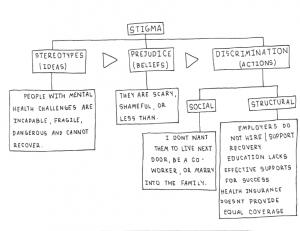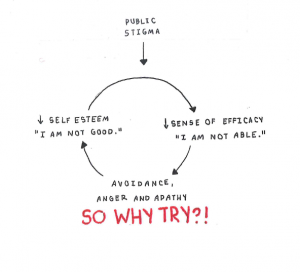
The first step in understanding WISE’s mission is to ask two very important questions – what is stigma, and where does it come from? It’s really simple – stigma is a false idea that can lead to misinformed beliefs that may result in harmful actions towards undeserving people. The illustration above goes deeper into the definition of “public” stigma, the stigma that people hold towards others.
In a previous post,
Self-Stigma: Internalizing Trauma we took a look at how external experiences are internalized, which can lead to self-shaming. Illustrated below, you’ll see the cycle is the same, but the focus has shifted from these experiences to public stigma, where those with mental health challenges experience exclusion and lack effective supports. Notice that the end result can be the same – a person gives up, and their sense of self-worth is diminished.
Unsurprisingly, public stigma’s primary driver is the media, which sets a biased precedent for what is newsworthy, based on what is or isn’t presented, and how we should feel about it. Often, these stories paint an incorrect portrait, or purposefully target the cases of substandard treatment – unethical research, negative drug side effects, or poor quality care, while ignoring stories of improvement or recovery. Beyond the news, we also see negative portrayals of people with mental health challenges being promoted in advertising, movies, and newspapers. It doesn’t take long to name a horror film or TV show that spreads or supports false stereotypes.
The media may also exert “benevolent stigma,” which depicts those with mental illness as lovable, but incapable. This may seem well meaning, but, in fact, it belittles and mocks their challenges by insinuating that their impact affects the person’s other capabilities. Another common type, called co-occurring, results when people experience stigma from more than one angle, that is if a person faces mental illness and identifies as apart of another stigmatized population group.
All of these false representations lead to an array of social issues that affect the human population worldwide. The impact is most seen on social inclusion, or the act of making all groups feel valued and important within a society. This is so critical because it encourages the beauty of diversity and promotes unity. Those facing social injustice may deal with lost employment, subpar housing, poor healthcare, diminished education opportunities, or alienation from their community.

These are big issues, and, contrary to popular belief, they’re not going away, at least not as quickly as we’d expect or like. The belief that the stigma surrounding mental illness is improving is true but does not acknowledge a complete picture. In fact, the percentage of Americans who view people with mental illness as dangerous doubled from 20% to 40% between 1956 and 1996.* This was over 20 years ago, so it may seem easy to disregard, but even more surprising is that this figure has remained steady at 40% from 1996 to 2006.**
This is not to shame and blame but to ask necessary questions about how false notions continue to be reinforced when, really, people facing mental health and addiction challenges are diverse and multi-dimensional, like everyone. We are all simply human in search of a happy and meaningful life. The question then becomes how to reverse the damage done and work toward WISE’s goal to end stigma and to build resilience, inclusion, and hope within our communities, countries, and the world.
We’ll explore this soon, so keep checking in, sign up for the WISE newsletter below for more information, or attend a WISE meeting to get more involved. All are welcome, and we’d love to meet you!
Thanks,
Lucy, and the WISE team
* BG Link, JC Phelan, M Bresnahan, A Stueve, BA Pescosolido American Journal of Public Health 89 (9), 1328-1333
** BH Link, JC Phelan – The Lancet, 2006
 The first step in understanding WISE’s mission is to ask two very important questions – what is stigma, and where does it come from? It’s really simple – stigma is a false idea that can lead to misinformed beliefs that may result in harmful actions towards undeserving people. The illustration above goes deeper into the definition of “public” stigma, the stigma that people hold towards others.
In a previous post, Self-Stigma: Internalizing Trauma we took a look at how external experiences are internalized, which can lead to self-shaming. Illustrated below, you’ll see the cycle is the same, but the focus has shifted from these experiences to public stigma, where those with mental health challenges experience exclusion and lack effective supports. Notice that the end result can be the same – a person gives up, and their sense of self-worth is diminished.
Unsurprisingly, public stigma’s primary driver is the media, which sets a biased precedent for what is newsworthy, based on what is or isn’t presented, and how we should feel about it. Often, these stories paint an incorrect portrait, or purposefully target the cases of substandard treatment – unethical research, negative drug side effects, or poor quality care, while ignoring stories of improvement or recovery. Beyond the news, we also see negative portrayals of people with mental health challenges being promoted in advertising, movies, and newspapers. It doesn’t take long to name a horror film or TV show that spreads or supports false stereotypes.
The media may also exert “benevolent stigma,” which depicts those with mental illness as lovable, but incapable. This may seem well meaning, but, in fact, it belittles and mocks their challenges by insinuating that their impact affects the person’s other capabilities. Another common type, called co-occurring, results when people experience stigma from more than one angle, that is if a person faces mental illness and identifies as apart of another stigmatized population group.
All of these false representations lead to an array of social issues that affect the human population worldwide. The impact is most seen on social inclusion, or the act of making all groups feel valued and important within a society. This is so critical because it encourages the beauty of diversity and promotes unity. Those facing social injustice may deal with lost employment, subpar housing, poor healthcare, diminished education opportunities, or alienation from their community.
The first step in understanding WISE’s mission is to ask two very important questions – what is stigma, and where does it come from? It’s really simple – stigma is a false idea that can lead to misinformed beliefs that may result in harmful actions towards undeserving people. The illustration above goes deeper into the definition of “public” stigma, the stigma that people hold towards others.
In a previous post, Self-Stigma: Internalizing Trauma we took a look at how external experiences are internalized, which can lead to self-shaming. Illustrated below, you’ll see the cycle is the same, but the focus has shifted from these experiences to public stigma, where those with mental health challenges experience exclusion and lack effective supports. Notice that the end result can be the same – a person gives up, and their sense of self-worth is diminished.
Unsurprisingly, public stigma’s primary driver is the media, which sets a biased precedent for what is newsworthy, based on what is or isn’t presented, and how we should feel about it. Often, these stories paint an incorrect portrait, or purposefully target the cases of substandard treatment – unethical research, negative drug side effects, or poor quality care, while ignoring stories of improvement or recovery. Beyond the news, we also see negative portrayals of people with mental health challenges being promoted in advertising, movies, and newspapers. It doesn’t take long to name a horror film or TV show that spreads or supports false stereotypes.
The media may also exert “benevolent stigma,” which depicts those with mental illness as lovable, but incapable. This may seem well meaning, but, in fact, it belittles and mocks their challenges by insinuating that their impact affects the person’s other capabilities. Another common type, called co-occurring, results when people experience stigma from more than one angle, that is if a person faces mental illness and identifies as apart of another stigmatized population group.
All of these false representations lead to an array of social issues that affect the human population worldwide. The impact is most seen on social inclusion, or the act of making all groups feel valued and important within a society. This is so critical because it encourages the beauty of diversity and promotes unity. Those facing social injustice may deal with lost employment, subpar housing, poor healthcare, diminished education opportunities, or alienation from their community.
 These are big issues, and, contrary to popular belief, they’re not going away, at least not as quickly as we’d expect or like. The belief that the stigma surrounding mental illness is improving is true but does not acknowledge a complete picture. In fact, the percentage of Americans who view people with mental illness as dangerous doubled from 20% to 40% between 1956 and 1996.* This was over 20 years ago, so it may seem easy to disregard, but even more surprising is that this figure has remained steady at 40% from 1996 to 2006.**
This is not to shame and blame but to ask necessary questions about how false notions continue to be reinforced when, really, people facing mental health and addiction challenges are diverse and multi-dimensional, like everyone. We are all simply human in search of a happy and meaningful life. The question then becomes how to reverse the damage done and work toward WISE’s goal to end stigma and to build resilience, inclusion, and hope within our communities, countries, and the world.
We’ll explore this soon, so keep checking in, sign up for the WISE newsletter below for more information, or attend a WISE meeting to get more involved. All are welcome, and we’d love to meet you!
Thanks,
Lucy, and the WISE team
* BG Link, JC Phelan, M Bresnahan, A Stueve, BA Pescosolido American Journal of Public Health 89 (9), 1328-1333
** BH Link, JC Phelan – The Lancet, 2006
These are big issues, and, contrary to popular belief, they’re not going away, at least not as quickly as we’d expect or like. The belief that the stigma surrounding mental illness is improving is true but does not acknowledge a complete picture. In fact, the percentage of Americans who view people with mental illness as dangerous doubled from 20% to 40% between 1956 and 1996.* This was over 20 years ago, so it may seem easy to disregard, but even more surprising is that this figure has remained steady at 40% from 1996 to 2006.**
This is not to shame and blame but to ask necessary questions about how false notions continue to be reinforced when, really, people facing mental health and addiction challenges are diverse and multi-dimensional, like everyone. We are all simply human in search of a happy and meaningful life. The question then becomes how to reverse the damage done and work toward WISE’s goal to end stigma and to build resilience, inclusion, and hope within our communities, countries, and the world.
We’ll explore this soon, so keep checking in, sign up for the WISE newsletter below for more information, or attend a WISE meeting to get more involved. All are welcome, and we’d love to meet you!
Thanks,
Lucy, and the WISE team
* BG Link, JC Phelan, M Bresnahan, A Stueve, BA Pescosolido American Journal of Public Health 89 (9), 1328-1333
** BH Link, JC Phelan – The Lancet, 2006